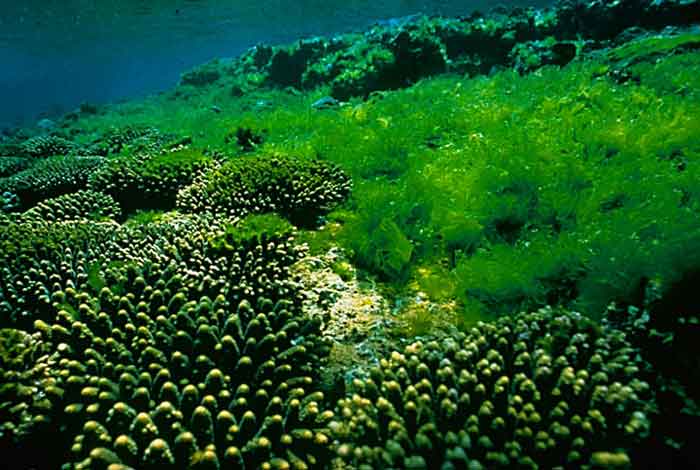Algae
Algae are the fastest growing photosynthesizing organisms, with growth cycles that reach completion in a few days. They rapidly fix atmospheric CO2 into biomass, reaching up to double their biomass every 24 hours (Christi, 2007). Of the many types of algae, green algae are the best at sequestering CO2 (Jackson, 1968).
Algae can be grown in photobioreactors, which are comprised of algae-filled glass tubes through which CO2 is bubbled. Algae grown in photobioreactors can then be harvested for biofuel production (Christi, 2007).

The image above shows the process by which the algae are transformed into fuel. Algae are grown inside the polycarbonate tubes by pumping CO2 and other nutrients into the water and letting them absorb light to metabolize such compounds through photosynthesis and transform them into more complex molecules like oil. The biomass is separated from the water through a physical process similar to centrifugation or sedimentation. The water is then recycled through the reactor. Oil is separated from the rest of the biomass through cell disruption and is then converted to biofuel through a process call transesterification, and the rest of the biomass is mostly converted into methane through anaerobic digestion. The biofuel is then sold as fuel and the methane is used to supply energy to the reactor. Any excess can be used for other purposes, such as animal feed, irrigation water, or fertilizer.
Advantages:
-
Biofuel production by means of algae cultivation produces a carbon-neutral fuel with 98% of the combustion efficiency of petroleum based diesel (Christi, 2007).
-
The CO2 produced by the burning of biogas can be pumped back into the reactor (Christi, 2008).
-
Since the process of producing biofuel using algae is carbon neutral, substituting regular petroleum-based fuels with biofuel would reduce the world's total CO2 emissions by 14%.
Disadvantages:
-
Algae biofuel is currently more expensive than petroleum-based fuels. (National Academy of Sciences (NAS), National Academy of Engineering (NAE), National Research Council (NRC), 2009).
Potential Storage Sites:
-
Algae thrives in temperatures between 20°C-30°C (Christi, 2007), which would make tropics preferable due to their constant temperature, but production plants can be placed anywhere.
-
Photobioreactors can also be placed on top of coal fired power plants, exemplified by the reactor on the roof of the MIT power plant (Stauffer, 2006).
Capacity Estimates:
-
To produce 100 tons of biomass using this process, roughly 183 tons of carbon dioxide are fixed; however, since most of this is burnt again, the overall process, taking into consideration the energy supply needed for it, is carbon neutral (Christi, 2007).
-
Biomass yields in closed photo-bioreactors can approach 150 tons per hectare per year (Carlsson et al, 2007).
-
Biodiesel yields range from 58,700 L/ha-yr to 136,900 L/ha-yr (Christi, 2007).
Cost Estimates:
-
The cost of building photobioreactors is currently estimated at about US$1,000,000 per hectare (Stucki, 2009).
-
The associated cost of a reactor (maintenance and others) is less than $150,000 per hectare (Schenk et al, 2008)
-
The cost of fuel produced from algae is about $2.80 per liter, using as reference the information reported by small plants. This cost is higher than the price of regular diesel used today. However, the production cost reduces to $0.72 when using algae species with a high oil concentration processed in a plant with a production of 10,000 t per year (Christ, 2007).


